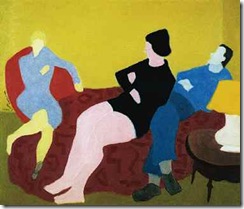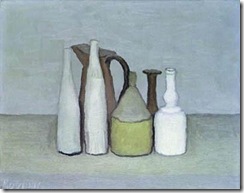Just dipping into a few fairly ordinary books on beginning painting the other day, I found some interesting tips and ideas. I’ve translated and added to them somewhat…but the initial information was from painting books.
Many authors advocate making what they call thumbnail sketches. These are small rough drawings and are very helpful in planning the arrangement of shapes, values and ideas in your piece before you begin to cut out the fabric . I think working on unlined 3 by 5 index cards would help to keep it simple. Or cut up old holiday cards, they often have at least one blank side, they’re small and it’s a great way to recycle! Look at the scene (if working from a photo) or into your imagination and locate no more than 5 to 6 major shapes. To find the major shapes in a scene, go by value rather than by object – i.e. if a boat and its shadow are both the same dark value then consider them one shape – it would certainly be an interesting one!
Move the shapes around to get the most interesting arrangement – remember Nature doesn’t always get it right, and man made elements are rarely perfectly arranged in real life. You can always alter the value of certain areas to if that would yield a more interesting shape.

Look at paintings – like those of Milton Avery – where the painter is pulling out interlocking shapes from a scene – and see if you can find similar shapes.
Here’s one of his pictures from the Neuberger Museum of Art: see how he’s simplified the people into 2 or 3 main shapes?

Or how about Giorgio Morandi? Here’s one of his pictures from Bologna Incoming. Someone suggested I look at these when I next compose a piece about vertical storage tanks! Below is the one I just made…it would be very interesting to try again with Morandi in mind….
Back to the index cards and shapes: It’s fun to try different arrangements: e.g. if you’re working on a landscape, try both a high and a low horizon line – don’t put it slap bang in the middle that tends to cut things in half.
If you are the kind of person who likes to cut shapes from fabric and arrange them directly on the wall….then cut or tear shapes from paper (you don’t need multiple colours, 3 or 4 values would be sufficient) and arrange them onto the card. When you have an arrangement you like – glue them down. The great thing is you can do this with your feet up watching telly and a glass of wine at your elbow!!
Don’t bother with details…but do have an idea where your focal area will be – it helps if that is where there is a significant contrast in value.
So, get down to the public library (they need support, especially here in the US) and take out an armload of painting books!!! It’s all in there!!! And, if you have been, thanks for reading! Elizabeth
















4 comments:
This is a really useful tip, one I was also given by Susan Brandeis at a workshop last year. I simply divide a sketchbook page/pages up and draw tiny ones to start with and find it helps to set a minimum: on the basis that first ideas aren't necessarily the best, and once you get rid of the obvious ones the more interesting ones start coming through. I also find it helpful to work quickly on this. It works for me - but only when i remember to do it!
I, for one, wish you would write a book on Art and Quilting because those books on beginning painting or watercolor or whatever other media they use, eventually focus on the medium and then we need yet another source. And, if we are indeed an art, why can't we have a book about how to make quilt art, just as there are books about painting art, etc.? I respect and appreciate your knowledge and wish you would assemble all that you know into a book that represents US for the other disciplines.
People teaching painting could say, "Read that book by Elizabeth Barton to learn a little more about color and composition." Maybe--in addition to examples from painting--there could be examples from fine quilting. Not a book about quilting but an art book with quilting as the medium. We have some wonderful art books of quilts, but they don't talk about composition or anything. We look and learn but we're kind of on our own to interpret sometimes. Give it a go, will you, please?!!!
I really love reading your posts. This one on method of composition is excellent. I am trying to begin all over again, and not think in the same way as I used to many years ago. It is like learning to walk all over again. Your ideas about working small seem manageable. Sometimes beginning is a little daunting. I agree on the use of the library as well as the use of books on art.
Post a Comment